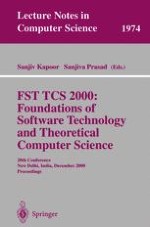2000 | Buch
FST TCS 2000: Foundations of Software Technology and Theoretical Computer Science
20th Conference New Delhi, India, December 13–15, 2000 Proceedings
herausgegeben von: Sanjiv Kapoor, Sanjiva Prasad
Verlag: Springer Berlin Heidelberg
Buchreihe : Lecture Notes in Computer Science
Enthalten in: Professional Book Archive
